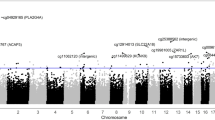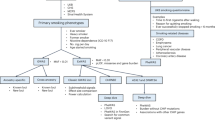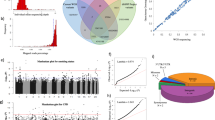Abstract
The relative importance of specific genetic and environmental factors in regulating nicotine dependence (ND) risk, including the effects on specific forms of childhood adversity on smoking risk, have been understudied. Genome-wide association studies and rodent models have demonstrated that the α5 nicotinic acetylcholine receptor gene (CHRNA5) is important in regulating nicotine intake. Childhood adversity increases the methylation level of the CHRNA5 promoter region in European Americans (EAs), an effect that was observed only in males (Zhang et al, submitted for publication). In view of this potential sex difference in the effects of early life experience on smoking, we investigated the presence of a sex-specific gene-by-environment effect of this marker on ND risk. A nonsynonymous SNP in CHRNA5 previously associated to ND and several related traits, rs16969968, was genotyped in 2206 EAs (1301 men and 905 women). The main and interactive effects of childhood adversity and rs16969968 genotype on diagnosis of ND and ND defined by dichotomized Fagerstrom test for ND (FTND) scores were explored. Men and women were analyzed separately to test for sex differences. Childhood adversity significantly increased ND risk in both sexes, and the effect in women was twice than that in men. Significant interactive effects of childhood adversity and rs16969968 genotype were observed in men (ND: OR=1.80, 95% CI=1.18–2.73, P=0.0044; FTND: OR=1.79, 95% CI=1.11–2.88, P=0.012). No interaction was found in women. This study provides evidence of a sex-specific gene × environment effect of CHRNA5 and childhood adversity on the risk for ND.
Similar content being viewed by others
Log in or create a free account to read this content
Gain free access to this article, as well as selected content from this journal and more on nature.com
or
References
Anda RF, Croft JB, Felitti VJ, Nordenberg D, Giles WH, Williamson DF et al (1999). Adverse childhood experiences and smoking during adolescence and adulthood. JAMA 282: 1652–1658.
Bierut LJ, Stitzel JA, Wang JC, Hinrichs AL, Grucza RA, Xuei X et al (2008). Variants in nicotinic receptors and risk for nicotine dependence. Am J Psychiatry 165: 1163–1171.
Blumberg SJ, Luke JV (2010). Wireless Substitution: Early Release of Estimates from the National Health Interview Survey, July–December 2009. CDC/National Center for Health Statistics, June 2011. Available from: http://www.cdc.gov/nchs/nhis.htm.
Carmelli D, Swan GE, Robinette D, Fabsitz R (1992). Genetic influence on smoking—a study of male twins. N Engl J Med 327: 829–833.
Carmody TP (1989). Affect regulation, nicotine addiction, and smoking cessation. J Psychoactive Drugs 21: 331–342.
Copeland WE, Keeler G, Angold A, Costello EJ (2007). Traumatic events and posttraumatic stress in childhood. Arch Gen Psychiatry 64: 577–584.
Douglas KR, Chan G, Gelernter J, Arias AJ, Anton RF, Weiss RD et al (2010). Adverse childhood events as risk factors for substance dependence: partial mediation by mood and anxiety disorders. Addict Behav 35: 7–13.
Erlich PM, Hoffman SN, Rukstalis M, Han JJ, Chu X, Linda Kao WH et al (2010). Nicotinic acetylcholine receptor genes on chromosome 15q25.1 are associated with nicotine and opioid dependence severity. Hum Genet 128: 491–499.
Fagen ZM, Mitchum R, Vezina P, McGehee DS (2007). Enhanced nicotinic receptor function and drug abuse vulnerability. J Neurosci 27: 8771–8778.
Fagerstrom KO (1978). Measuring degree of physical dependence to tobacco smoking with reference to individualization of treatment. Addict Behav 3: 235–241.
Falush D, Stephens M, Pritchard JK (2003). Inference of population structure using multilocus genotype data: linked loci and correlated allele frequencies. Genetics 164: 1567–1587.
Fowler CD, Lu Q, Johnson PM, Marks MJ, Kenny PJ (2011). Habenular alpha5 nicotinic receptor subunit signalling controls nicotine intake. Nature 471: 597–601.
Furberg H, Kim Y, Dackor J, Boerwinkle E, Franceschini N, Ardissino D et al (2010). Genome-wide meta-analyses identify multiple loci associated with smoking behavior. Nat Genet 42: 441–447.
Gelernter J, Panhuysen C, Weiss R, Brady K, Hesselbrock V, Rounsaville B et al (2005). Genomewide linkage scan for cocaine dependence and related traits: significant linkages for a cocaine-related trait and cocaine-induced paranoia. Am J Med Genet B Neuropsychiatr Genet 136B: 45–52.
Gelernter J, Panhuysen C, Wilcox M, Hesselbrock V, Rounsaville B, Poling J et al (2006). Genomewide linkage scan for opioid dependence and related traits. Am J Hum Genet 78: 759–769.
Gross CM, Flubacher A, Tinnes S, Heyer A, Scheller M, Herpfer I et al (2010). Early life stress stimulates hippocampal reelin gene expression in a sex-specific manner: evidence for corticosterone-mediated action. Hippocampus (e-pub ahead of print 6 December 2010).
Heatherton TF, Kozlowski LT, Frecker RC, Fagerstrom KO (1991). The Fagerstrom test for nicotine dependence: a revision of the Fagerstrom tolerance questionnaire. Br J Addict 86: 1119–1127.
Heim C, Bradley B, Mletzko TC, Deveau TC, Musselman DL, Nemeroff CB et al (2009). Effect of childhood trauma on adult depression and neuroendocrine function: sex-specific moderation by CRH receptor 1 gene. Front Behav Neurosci 3: 41.
Jaenisch R, Bird A (2003). Epigenetic regulation of gene expression: how the genome integrates intrinsic and environmental signals. Nat Genet 33 (Suppl): 245–254.
Johnson EO, Chen LS, Breslau N, Hatsukami D, Robbins T, Saccone NL et al (2010). Peer smoking and the nicotinic receptor genes: an examination of genetic and environmental risks for nicotine dependence. Addiction (Abingdon, England) 105: 2014–2022.
Jun HJ, Rich-Edwards JW, Boynton-Jarrett R, Austin SB, Frazier AL, Wright RJ (2008). Child abuse and smoking among young women: the importance of severity, accumulation, and timing. J Adolesc Health 43: 55–63.
Kendler KS, Bulik CM, Silberg J, Hettema JM, Myers J, Prescott CA (2000). Childhood sexual abuse and adult psychiatric and substance use disorders in women: an epidemiological and cotwin control analysis. Arch Gen Psychiatry 57: 953–959.
Liu JZ, Tozzi F, Waterworth DM, Pillai SG, Muglia P, Middleton L et al (2010). Meta-analysis and imputation refines the association of 15q25 with smoking quantity. Nat Genet 42: 436–440.
McCarthy MM, Auger AP, Bale TL, De Vries GJ, Dunn GA, Forger NG et al (2009). The epigenetics of sex differences in the brain. J Neurosci 29: 12815–12823.
McGowan PO, Sasaki A, D’Alessio AC, Dymov S, Labonte B, Szyf M et al (2009). Epigenetic regulation of the glucocorticoid receptor in human brain associates with childhood abuse. Nat Neurosci 12: 342–348.
Myers US, Hutchison KE, Filbey FM (2010). Large variability in smokers obscure the G × E effects on tobacco dependence. Psychiatry Res 177: 369–370.
Newman TK, Parker CC, Suomi SJ, Goldman D, Barr CS, Higley JD (2009). DRD1 5′UTR variation, sex and early infant stress influence ethanol consumption in rhesus macaques. Genes Brain Behav 8: 626–630.
Nichols HB, Harlow BL (2004). Childhood abuse and risk of smoking onset. J Epidemiol Community Health 58: 402–406.
Nugent BM, McCarthy MM (2011). Epigenetic underpinnings of developmental sex differences in the brain. Neuroendocrinology 93: 150–158.
Pierucci-Lagha A, Gelernter J, Chan G, Arias A, Cubells JF, Farrer L et al (2007). Reliability of DSM-IV diagnostic criteria using the semi-structured assessment for drug dependence and alcoholism (SSADDA). Drug Alcohol Depend 91: 85–90.
Pierucci-Lagha A, Gelernter J, Feinn R, Cubells JF, Pearson D, Pollastri A et al (2005). Diagnostic reliability of the semi-structured assessment for drug dependence and alcoholism (SSADDA). Drug Alcohol Depend 80: 303–312.
Pritchard JK, Rosenberg NA (1999). Use of unlinked genetic markers to detect population stratification in association studies. Am J Hum Genet 65: 220–228.
Pritchard JK, Stephens M, Donnelly P (2000). Inference of population structure using multilocus genotype data. Genetics 155: 945–959.
Roth TL, Lubin FD, Funk AJ, Sweatt JD (2009). Lasting epigenetic influence of early-life adversity on the BDNF gene. Biol Psychiatry 65: 760–769.
Rucklidge JJ, Brown DL, Crawford S, Kaplan BJ (2006). Retrospective reports of childhood trauma in adults with ADHD. J Atten Disord 9: 631–641.
Sherva R, Kranzler HR, Yu Y, Logue MW, Poling J, Arias AJ et al (2010). Variation in nicotinic acetylcholine receptor genes is associated with multiple substance dependence phenotypes. Neuropsychopharmacology 35: 1921–1931.
Shi MM (2001). Enabling large-scale pharmacogenetic studies by high-throughput mutation detection and genotyping technologies. Clin Chem 47: 164–172.
Thorgeirsson TE, Gudbjartsson DF, Surakka I, Vink JM, Amin N, Geller F et al (2010). Sequence variants at CHRNB3-CHRNA6 and CYP2A6 affect smoking behavior. Nat Genet 42: 448–453.
True WR, Xian H, Scherrer JF, Madden PA, Bucholz KK, Heath AC et al (1999). Common genetic vulnerability for nicotine and alcohol dependence in men. Arch Gen Psychiatry 56: 655–661.
Weaver IC, Cervoni N, Champagne FA, D’Alessio AC, Sharma S, Seckl JR et al (2004). Epigenetic programming by maternal behavior. Nat Neurosci 7: 847–854.
Widom CS, DuMont K, Czaja SJ (2007). A prospective investigation of major depressive disorder and comorbidity in abused and neglected children grown up. Arch Gen Psychiatry 64: 49–56.
Xie P, Kranzler HR, Poling J, Stein MB, Anton RF, Brady K et al (2009). Interactive effect of stressful life events and the serotonin transporter 5-HTTLPR genotype on posttraumatic stress disorder diagnosis in 2 independent populations. Arch Gen Psychiatry 66: 1201–1209.
Yang BZ, Zhao H, Kranzler HR, Gelernter J (2005). Practical population group assignment with selected informative markers: characteristics and properties of Bayesian clustering via STRUCTURE. Genet Epidemiol 28: 302–312.
Zeger SL, Liang KY (1986). Longitudinal data analysis for discrete and continuous outcomes. Biometrics 42: 121–130.
Zhang H, Herman A, Kranzler HR, Anton RF, Zhao H, Zheng W et al (submitted for publication). Array-based profiling of DNA methylation: changes associated with alcohol dependence and influenced by childhood adversity.
Acknowledgements
We thank the individuals and families participating in this work and the interviewers at all the participating sites for collecting the data. This study was supported by NIH Grants R01 DA12690, R01 DA12849, and R01 AA11330.
Author information
Authors and Affiliations
Corresponding author
Ethics declarations
Competing interests
Dr Kranzler has received consulting fees from Alkermes, GlaxoSmithKline, Gilead, and Lundbeck and research support from Merck. Dr Anton reports for the last 2 years, being a consultant for Eli Lilly, GlaxoSmithKline, and Alkermes. Drs Kranzler and Anton also report associations with Eli Lilly, Merck, Janssen, Schering Plough, Lundbeck, Alkermes, GlaxoSmithKline, Abbott, and Johnson & Johnson, as these companies provide support to the ACNP Alcohol Clinical Trials Initiative (ACTIVE) and they receive support from ACTIVE. Dr Gelernter reports that he has received compensation for professional services in the previous 3 years from the following entities: Yale University School of Medicine, Veterans Affairs Healthcare System (VA), and the National Institutes of Health (NIAAA, NIDA, and NIMH), and related to academic lectures and editorial functions in various scientific venues (including the ACNP). The other authors declared no conflict of interest.
Additional information
Supplementary Information accompanies the paper on the Neuropsychopharmacology website
Supplementary information
PowerPoint slides
Rights and permissions
About this article
Cite this article
Xie, P., Kranzler, H., Zhang, H. et al. Childhood Adversity Increases Risk for Nicotine Dependence and Interacts with α5 Nicotinic Acetylcholine Receptor Genotype Specifically in Males. Neuropsychopharmacol 37, 669–676 (2012). https://doi.org/10.1038/npp.2011.240
Received:
Revised:
Accepted:
Published:
Issue date:
DOI: https://doi.org/10.1038/npp.2011.240
Keywords
This article is cited by
-
Child marriage and risky health behaviors: an analysis of tobacco use among early adult and early middle-aged women in India
BMC Women's Health (2022)
-
Childhood life events, immune activation and the development of mood and anxiety disorders: the TRAILS study
Translational Psychiatry (2017)
-
Early life adversity influences stress response association with smoking relapse
Psychopharmacology (2017)
-
Converging findings from linkage and association analyses on susceptibility genes for smoking and other addictions
Molecular Psychiatry (2016)
-
Contribution of Variants in CHRNA5/A3/B4 Gene Cluster on Chromosome 15 to Tobacco Smoking: From Genetic Association to Mechanism
Molecular Neurobiology (2016)



